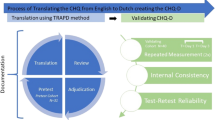Abstract
The process of translating the Short-Form Headache Impact Test (HIT-6) in 27 countries and the comparability of the content of the translations is discussed. HIT-6 translations were developed using a standard forward–backward translation process, including a cognitive debriefing step and international harmonization of the translations. Prior to translating the HIT-6, modifications were made to the English-language source form, to improve translation equivalence. In general, the HIT-6 was not difficult to translate. The most difficult items included colloquial expressions such as 'fed up' and words whose intended meaning changed in translation such as 'school' or 'lie down.' Subjects generally found the HIT-6 translations to be clear and relevant. The translation process resulted in questionnaires that are both culturally appropriate and comparable in content.
Similar content being viewed by others
References
Gandek B, Ware JE. Translating functional health and well-being: International Quality of Life Assessment (IQOLA) Project studies of the SF-36 Health Survey. J Clin Epidemiol 1998; 11: 891–1214.
Bergner M, Bobbitt RA, Carter WB, Gilson BS. The Sickness Impact Profile: Development and final revision of a health status measure. Med Care 1981; 19: 787–805.
Hunt SM, McKenna S. Cross-cultural comparability of quality of life measures. British J Med Econ 1992; 4: 17–23.
Aaronson NK, Cull A, Kaasa S, Sprangers MAG. The EORTC modular approach to quality of life assessment in oncology. Int J Mental Health 1994; 23: 75–96.
WHOQOL Group. Division of Mental Health, World Health Organization. Study protocol for the World Health Organization project to develop a quality of life assessment instrument (WHOQOL). Qual Life Res 1993; 2: 153–159.
Patrick DL, Martin ML, Bushnell DM, Marquis P, Andrejasich CM, Buesching DP. Cultural adaptation of a quality-of-life measure for urinary incontinence. Euro Urol 1999; 36: 427–435.
Spertus JA, Winder JA, Dewhurst TA, et al. Development and evaluation of the Seattle Angina Questionnaires: A new functional status measure for coronary artery disease. J Am Coll Cardiol 1995; 25: 333–341.
Ware JE, Kosinski M, Dewey JE, Gandek B. How to Score and Interpret Single-Item Health Status Measures: A Manual for Users of the SF-8-Health Survey. Lincoln (RI): QualityMetric Incorporated, 2001.
Kosinski M, Bayliss MS, Bjorner JB, et al. A six-item short-form survey for measuring headache impact: The HIT-6. Qual Life Res 2003; 12: 963–974.
Wagner AK, Gandek B, Aaronson NK, et al. Cross-cultural comparisons of the content of SF-36 translations across 10 countries: Results from the IQOLA Project. J Clin Epidemiol 1998; 11: 925–932.
Keller SD, Ware JE, Gandek B, et al. Testing the equivalence of translations of widely used response choice labels: Results from the IQOLA Project. J Clin Epidemiol 1998; 11: 933–944.
Bullinger M, Alonso J, Apolone G, et al. Translating health status questionnaires and evaluating their quality: The IQOLA Project approach. J Clin Epidemiol 1998; 11: 913–923.
Brislin RW, Lonner WJ, Thorndike RM (eds.). Cross-Cultural Research Methods. New York: Wiley, 1973.
Scientific Advisory Committee of the Medical Outcomes Trust. Assessing health status and quality-of-life instruments: Attributes and review criteria. Qual Life Res 2002; 11: 193–205.
Acquadro C, Jambon B, Ellis D, Marquis P. Language and translation issues. In: Spilker B (eds.), Quality of Life and Pharmacoeconomics in Clinical Trials, Philadelphia: Lippincott-Raven Publishers, 1996: 575–585.
Author information
Authors and Affiliations
Rights and permissions
About this article
Cite this article
Gandek, B., Alacoque, J., Uzun, V. et al. Translating the Short-Form Headache Impact Test (HIT-6) in 27 countries: Methodological and conceptual issues. Qual Life Res 12, 975–979 (2003). https://doi.org/10.1023/A:1026171315263
Issue Date:
DOI: https://doi.org/10.1023/A:1026171315263




